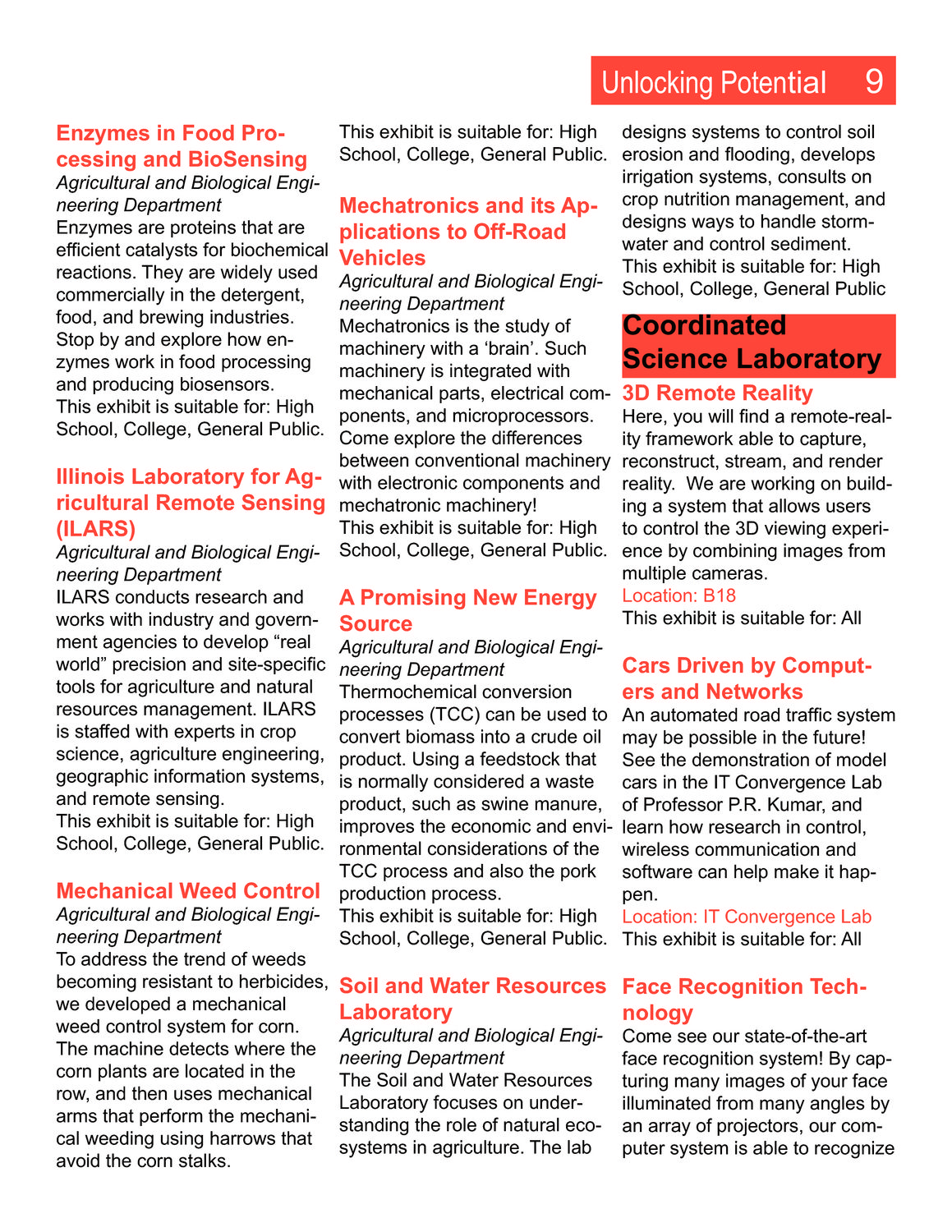Caption: Engineering Open House Guide - 2009
This is a reduced-resolution page image for fast online browsing.

EXTRACTED TEXT FROM PAGE:
Unlocking Potential Enzymes in Food Processing and BioSensing Agricultural and Biological Engineering Department Enzymes are proteins that are efficient catalysts for biochemical reactions. They are widely used commercially in the detergent, food, and brewing industries. Stop by and explore how enzymes work in food processing and producing biosensors. This exhibit is suitable for: High School, College, General Public. 9 Illinois Laboratory for Agricultural Remote Sensing (ILARS) Agricultural and Biological Engineering Department ILARS conducts research and works with industry and government agencies to develop “real world” precision and site-specific tools for agriculture and natural resources management. ILARS is staffed with experts in crop science, agriculture engineering, geographic information systems, and remote sensing. This exhibit is suitable for: High School, College, General Public. Agricultural and Biological Engineering Department Thermochemical conversion processes (TCC) can be used to convert biomass into a crude oil product. Using a feedstock that is normally considered a waste product, such as swine manure, improves the economic and environmental considerations of the TCC process and also the pork Mechanical Weed Control production process. Agricultural and Biological Engi- This exhibit is suitable for: High neering Department School, College, General Public. To address the trend of weeds becoming resistant to herbicides, Soil and Water Resources we developed a mechanical Laboratory weed control system for corn. Agricultural and Biological EngiThe machine detects where the neering Department corn plants are located in the The Soil and Water Resources row, and then uses mechanical Laboratory focuses on underarms that perform the mechani- standing the role of natural ecocal weeding using harrows that systems in agriculture. The lab avoid the corn stalks. This exhibit is suitable for: High designs systems to control soil School, College, General Public. erosion and flooding, develops irrigation systems, consults on Mechatronics and its Ap- crop nutrition management, and designs ways to handle stormplications to Off-Road water and control sediment. Vehicles This exhibit is suitable for: High Agricultural and Biological Engi- School, College, General Public neering Department Mechatronics is the study of Coordinated machinery with a ‘brain’. Such Science Laboratory machinery is integrated with mechanical parts, electrical com- 3D Remote Reality ponents, and microprocessors. Here, you will find a remote-realCome explore the differences ity framework able to capture, between conventional machinery reconstruct, stream, and render with electronic components and reality. We are working on buildmechatronic machinery! ing a system that allows users This exhibit is suitable for: High to control the 3D viewing experiSchool, College, General Public. ence by combining images from multiple cameras. A Promising New Energy Location: B18 This exhibit is suitable for: All Source Cars Driven by Computers and Networks An automated road traffic system may be possible in the future! See the demonstration of model cars in the IT Convergence Lab of Professor P.R. Kumar, and learn how research in control, wireless communication and software can help make it happen. Location: IT Convergence Lab This exhibit is suitable for: All Face Recognition Technology Come see our state-of-the-art face recognition system! By capturing many images of your face illuminated from many angles by an array of projectors, our computer system is able to recognize
|